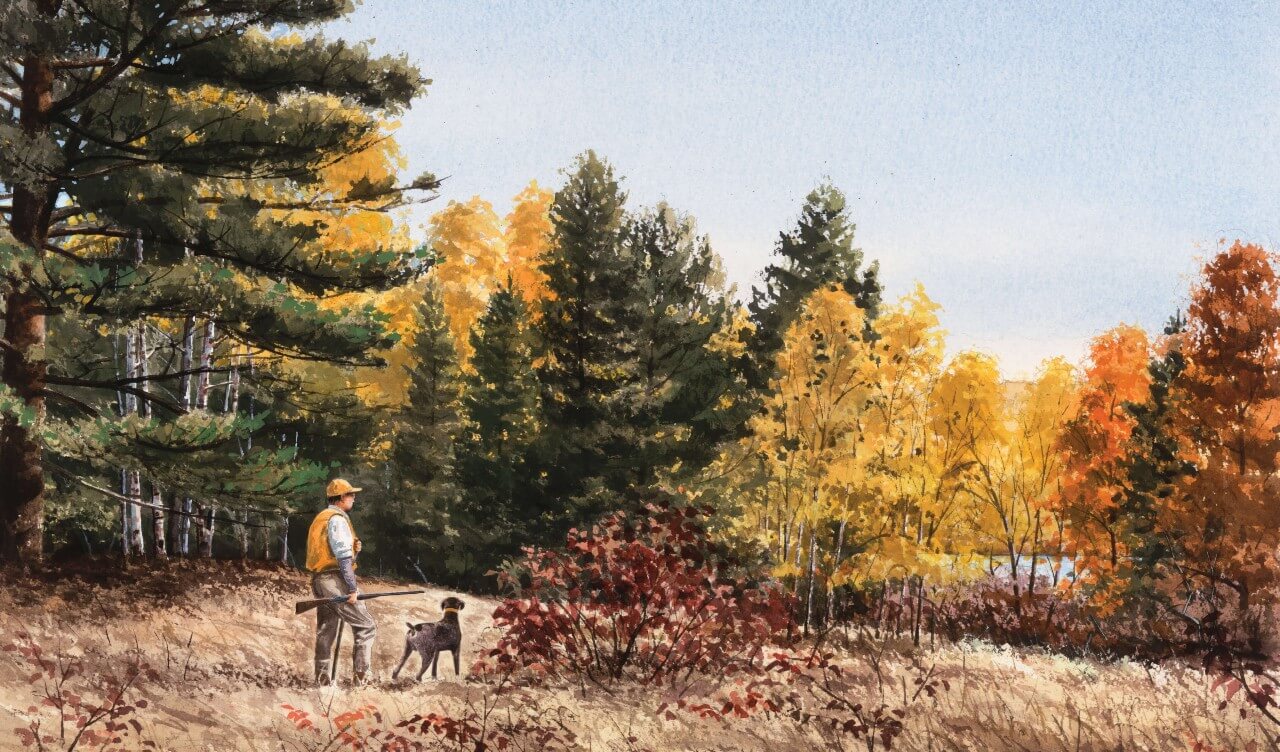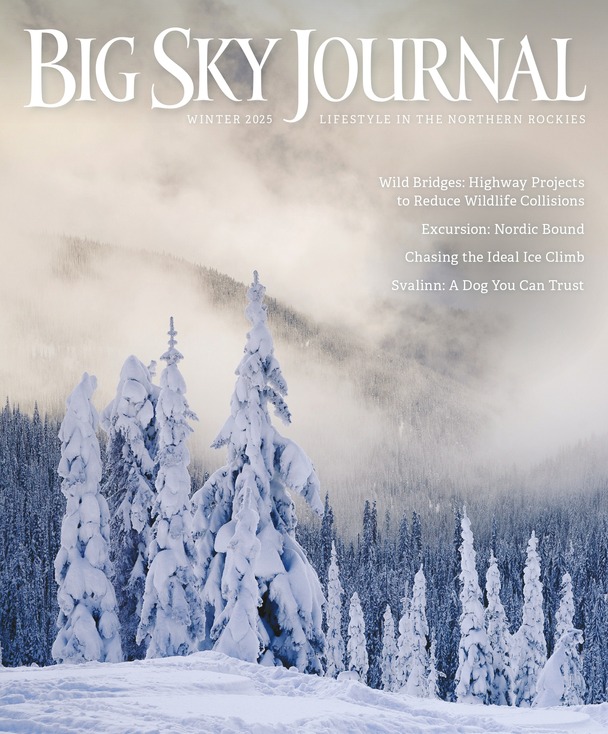
25 Sep Outside: An Active Participant
In the predawn black, I trek up to a saddle off Emigrant Peak’s west flank, nestling into a small thicket of young Douglas fir to watch the day arrive. My back leans against an old rampike, a once-grand whitebark, stripped and bald, but still standing strong. Woodpecker nest holes pierce its bare midriff, and small, punched-out beetle holes dot its nether regions. Gray curls rise from the thermos of coffee steaming in the cold darkness with each unscrewing of the lid. The September dawn, when it comes, rolls up from the Absaroka Mountains in broad Rothko-esque bands of indigo, caramel, rust, and saffron, accenting the few aspen and cottonwood leaves that still cling to their branches. I put away the coffee and bring out the binoculars.
Emigrant Peak stands up so proudly from Paradise Valley that it appears larger than life. I lived under its gaze for many years before I realized it was not the highest peak in the range. Nonetheless, its vast corrugations of ridgelines and gullies hide some very remote country. A few years ago, a friend and I hiked for many hours up and down these ridgelines in a pilgrimage to an old Cold War-era B-47 that slammed into one of them during a training mission on July 23, 1962. We tracked its spilled wreckage across and down two valleys, in awe that this scale of devastation could be hidden amid the mountain’s massive folds. The impact site still scars the mountainside. Burnt trees wield shards of metal fuselage and wing, embedded like knives in their sides. The last thing we found was the landing gear, two valleys over, and a mile away.
This morning, I am hunting elk. There is no shortage of their spoor — numerous tracks, compressed beds, and waist-high rubs — but I don’t see anything to suggest they are still in the area. I follow a game trail off to the south, moving deliberately and mindfully, step by purposeful step, nose to the wind, eyes scanning for a leg, an antler, a twitching ear.
The first time I hunted was with my uncle. A Vietnam vet, his outdoorsmanship was regarded with awe by the family. It got him through the war, where, against all odds, he and one other survivor from his Marine platoon found their way back home through a treacherous jungle. After the war, he took to the woods and became a bow hunter. In the mountains of Colorado, he offered to let me come along. I must have been around 11 or 12 years old. It was cold out, and my mother had bundled me up in a big puffy coat and slick moon boots. As we walked through the woods, the swing of my arms announced our presence with an embarrassing “swish, swish, swish.” Needless to say, we didn’t see many animals that day. And though it must have driven my uncle crazy, he never said a word about it. As we camped that night, an entire herd of elk stampeded right past our tent, a boulder in the middle of their flowing stream. I remember lying in my sleeping bag, listening to — feeling — the power of hundreds of hooves rumbling past. I worried they might run us right over.
I didn’t hunt for many years after that. I became preoccupied with sports and school activities, and wasn’t sure of hunting’s place in a modern society. As I grew older, though, I became more distressed about where our food comes from. The industrial food complex — with its feed lots and hormone-stimulated, antibiotic-doped animals — concerned me greatly. Eventually recognizing that wild game was as organic and free-ranging as I could get, I began to hunt again.
The first day I ever went elk hunting was a prime example of beginner’s luck. As I sat next to a creek in the Crazy Mountains, I heard a splash behind me. There, not 40 yards off, was a 4-by-4 bull elk, hind legs still in the creek and unimaginably large. Shaking with adrenaline, I had to lie down and rest the rifle on my pack to steady it. The next year, I spied another big bull following a small creek upstream. I scrambled up to the ridge, ran to get ahead of him, and dropped back down to the creek to await his arrival. I was there when he rounded a bend just 25 yards away.
I found my way back to archery hunting the next season. My uncle made me a recurve bow and some wooden arrows. I loved the simplicity of archery. I was drawn to its philosophical, historical, and spiritual overtones. I discovered the pure joy that came with being close to these majestic creatures. One morning, I sat in a lush green meadow with a small herd of elk, breathing in their fragrant odor and listening to their chirping dialogue. I never took a shot that day but rather sat watching for hours, transfixed, until they moved on. I realized that the process of hunting — the connection it engenders with the natural world — could be even more meaningful than its end result.
Which was a good thing, because I failed to shoot anything else for the next three years.
Back on Emigrant Peak, I follow a game path across a high meadow into a draw. As the morning develops, a bouquet of dead leaves hangs in the air, tall grasses trace circles in a light breeze, and the dead bones of lupine and balsamroot rattle gently against one another. Climbing up the fall line of a north-facing slope dark with lodgepoles, the vague form of a mule deer comes into focus, filtering through the shadows above. Then another, and another.
Ducking behind a tree, I head downwind in an attempt to circle around behind them. I slink carefully along a well-trodden game trail leading around a bend where I’ll be out of sight. Suddenly, the quiet of the hillside is shattered by a clattering of hooves coming from around the bend.
Damn! I think. I must’ve spooked them. Instead, a young doe, ears pinned back, barrels right toward me. I recently read a study that suggested that cats can display over 300 facial expressions. I would have never thought a deer’s face could do the same, but I’m telling you this doe had a look of abject horror in her eyes. Stunned, I step back off the trail because, otherwise, she might run right over me. She doesn’t even look at me as I feel her breeze rush past. It’s all in slow motion. I want to reach out and caress her heaving flanks, but then she is gone.
Another skittering of stones comes from the same direction, and I step back again, fully expecting another deer to come racing past. This time, a massive dog comes bounding around the bend in great big strides. Who the hell’s dog is that?! Realization dawns slowly: Simultaneously powerful and supple, steel cables wrapped in fur, this is no domesticated dog — it’s a wolf!
He’s 20 yards and closing fast. I intensely want to watch him race past, too, to feel his power as I had the deer’s. But a niggling inner voice prods: If he’s that close to me, could he just decide to take the easier prey? Single-mindedly pursuing his quarry and oblivious to my presence, he rapidly closes the ground between him and the deer. And me. There is no time to draw an arrow. There is no time to think of the bear spray holstered at my side. But there is also, somehow, a peaceful lack of urgency or even fear.
Heeding the instinct for self-preservation, I raise my arms and yell “Hey!” And then I watch, in awe, as the beast, seemingly frozen midbound like Wile E. Coyote, turns himself completely around. By the time he hits the ground a mere 10 yards away, he is already facing away from me. In the most athletic move I’ve ever seen, he ricochets off the ground in the opposite direction, and is gone.
Witnessing something I was not supposed to, I’m left standing in the silent forest, dumbfounded. Not a squirrel chitters, the chickadees have gone mute, and the deer is long gone. Like a misty dream melting into the trees, the world slowly comes back to life. A vibrant sense of aliveness envelops me, but also a wondrously humbling appreciation of my own insignificance. The Japanese call this feeling mono no aware, a joyful compassion for the fact that we are all — the mountain, the deer, the wolf, all of us — nothing but ephemeral patterns destined to eventually fade. If not this minute, then the next.
I’m left to wonder if it all really happened. But I easily find the wolf’s softball-sized tracks deeply compressed in the forest’s duff. The earth always remembers. And I recall my own memories — of the elk flowing around my uncle’s tent, of their back-and-forth chirping and musky perfumery, and of the wolf, still frozen mid-air in my mind’s eye. My fondest memories, it seems, have nothing to do with killing but everything to do with a curious and undistracted engagement with the world.
These days, we possess the technology to kill quite easily. Not that this outcome doesn’t have benefits, but hunting is about the process. It is developing a relationship with the animals we seek, understanding the ecology and biology at work, and transcending our own myopic ambitions. Our ancestors evolved as hunters: They were participants in nature, not mere transient spectators. Modern humanity may be able to exist separately from nature — to be appeased by the occasional grand vista or scenic drive through a national park — but it would be an impoverished existence, for we are still possessed by our ancestors’ spirits, still yearning to be a part of the natural world.
Douglas Wadle is an internal medicine physician and a science and nature writer. He is the author of Einstein’s Violin: The Love Affair Between Science, Music, and History’s Most Creative Thinkers. He lives with his wife, Kristin, in Livingston, Montana.
Bob White is an artist and author whose work expresses a misspent youth. Instead of doing his homework, his nose was constantly in the outdoor books and sporting magazines of the day. Consequently, he has wandered between Alaska and Patagonia for over three decades as an itinerant fishing guide looking for gainful employment. He now paints and writes for a living; which is to say, he’s still searching.




No Comments